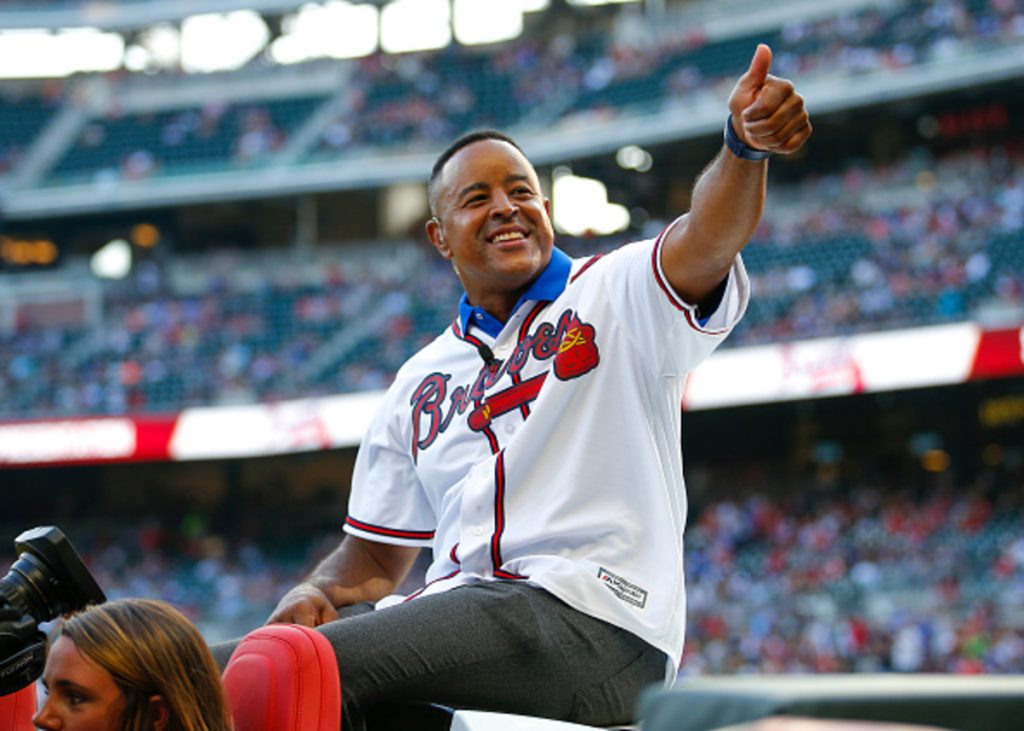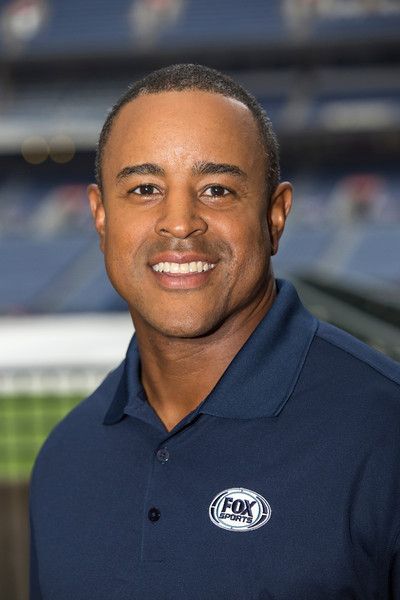ℹ Key Takeaways
- One of only 7 men to play both MLB and NFL since 1970
- Played 1,456 MLB games – most by any NFL player in history
- 1999 MLB All-Star with Cardinals, Braves, Dodgers, and Rangers
- Emmy-winning broadcaster for Bally Sports South after retirement
- Founded Brian Jordan Foundation in 1998 for childhood literacy
In the modern era of athletic specialization, where athletes dedicate their entire lives to mastering a single sport, Brian Jordan stands as one of only seven men who have played both Major League Baseball and NFL football since 1970. More remarkably, his 1,456 MLB games played represent the most by any NFL player, a testament to his exceptional versatility and determination to excel at the highest levels of professional sports.
Brian O’Neal Jordan is 57 years old, having been born on March 29, 1967, in Baltimore, Maryland, United States. Brian Jordan is married to Pam Bryant Jordan since 1996, and they have four children: Briana, Kenley, Bryson, and Kaleb. Brian Jordan’s height is 5 feet 11 inches, and his estimated net worth ranges from $2.5 million to $16 million, derived from his dual-sport career, Emmy-winning broadcasting work, and strategic business ventures.
Early Life and Foundation: The Making of a Two-Sport Athlete
Brian O’Neal Jordan was born on March 29, 1967, in Baltimore, Maryland, as the third child of Alvin and Betty Jordan. His father Alvin worked in a steel mill, while his mother Betty was a teacher. This combination created a household that valued both hard work and education. Jordan had twin siblings, Deric and Felicia, who were two years older.
The influence of his parents shaped Jordan’s character from an early age. His father told him, “No dream is too small. No dream is too big,” words that would later inspire Jordan to pursue the seemingly impossible goal of playing two professional sports simultaneously.
Athletic Development at Milford Mill High School
Brian Jordan was a sports star at Milford Mill High School in Baltimore, Maryland, where he excelled in baseball, football, and basketball. His multi-sport talents caught the attention of college recruiters, but Jordan faced a challenging decision that would define his future path.
The University of Maryland recruited Jordan for both sports, but the football program wouldn’t allow him to play baseball as a freshman. Jordan matriculated at the University of Richmond instead so he could follow his dream of being a two-sport athlete. At Richmond, Jordan was named All-America and all-conference in football while also earning all-conference honors in baseball. He graduated in 1989 with a Bachelor of Arts in Sociology.

What made Brian Jordan different? Jordan’s decision to choose Richmond over Maryland demonstrated his unwavering commitment to pursuing excellence in multiple sports, a choice that would prove prophetic for his professional career.
Breaking Into Professional Sports: The Dual-Career Launch
Brian Jordan was selected in the first round of the 1988 MLB draft by the St. Louis Cardinals, while in the 1989 NFL draft, he was taken in the seventh round by the Buffalo Bills but was cut in training camp. However, he was quickly picked up by the Atlanta Falcons, where he played defensive back from 1989 to 1991.
Jordan had five interceptions and four sacks in his brief NFL career, establishing himself as a capable safety. During the 1991 season, he was named an alternate to the Pro Bowl team, highlighting his impact on the field despite the challenges of balancing two professional sports.
The logistics of maintaining dual careers proved demanding. While he played in the Cardinals’ minor league system, Jordan also played defensive back for the Falcons, requiring exceptional physical and mental stamina to excel in both sports.
The Critical Decision: Choosing Baseball Over Football
In June 1992, Brian Jordan signed a new contract with St. Louis giving him a $1.7 million signing bonus to give up football and play baseball exclusively, ending his football career. This decision marked a turning point that would define the remainder of his athletic career.
Jordan made his MLB debut on April 8, 1992, with the Cardinals. Initially, he played mostly as a utility outfielder during his first three seasons, gradually establishing himself as a reliable player while adapting to the demands of full-time baseball.
The transition proved worthwhile. In his first full year in 1995, his stats included 145 hits, 24 doubles, and a .296 batting average in 490 at-bats. He also hit 22 home runs and 81 RBIs.
Career Peak and All-Star Recognition
Brian Jordan built on his success in 1996, hitting .310 with 104 RBIs and a .349 on-base percentage, playing mostly as the right fielder and cleanup hitter for the Cardinals. His clutch hitting became legendary: Jordan posted a .422 batting average with runners in scoring position (RISP), which became the Cardinals’ all-time highest mark.
Following a strong 1998 season, Jordan signed a $21.3 million contract to join the Atlanta Braves for the 1999 season. Jordan had a strong April and May to help carry the Braves early in the 1999 season. This propelled him to his only All-Star appearance. He finished the season with 100 runs again and drove in 115 runs.
In April 2002, Brian Jordan earned National League Player of the Month honors, further cementing his reputation as a consistent performer during his Atlanta Braves tenure.
In the 1999 NLDS against the Houston Astros, Jordan batted .471, had the game-winning double in the 12th inning of Game 3, and drove in seven of Atlanta’s 18 runs during the series.
Following his first tenure with the Braves, Jordan signed with the Los Angeles Dodgers, where he played for two seasons (2002-2003). He then spent the 2004 season with the Texas Rangers before returning to Atlanta for his final MLB season in 2006.
Key Achievement: Jordan’s career mark of 163 Total Zone Runs as an outfielder ranks seventh-best all time, demonstrating his exceptional defensive abilities alongside his offensive contributions.
Personal Life and Family Foundation
Who is Brian Jordan’s wife? Jordan and his wife, Pam (née Bryant), met at the University of Richmond, where she was an All-American basketball player. They married in 1996 and have four children: Briana, Kenley, Bryson, and Kaleb. The Jordans reside in Alpharetta, Georgia, a suburb of Atlanta.
Their partnership extended beyond marriage into academic recognition. In February 1995, they were jointly inducted into the University of Richmond Hall of Fame, becoming the first married couple to receive that honor.
How many children does Brian Jordan have? Brian Jordan and his wife Pam have four children together, representing a close-knit family unit that has remained largely private despite Jordan’s public career.
Beyond the Field: Philanthropy and Community Impact
Brian Jordan established the Brian Jordan Foundation in 1998, driven by his father’s early encouragement about the power of dreams. The foundation is committed to creating and supporting programs for children and their families that will directly improve their quality of life, with focus areas including Literacy, Health and Fitness, and Scholarships.
Literacy Advocacy and Children’s Books
Jordan authored children’s books including “I Told You I Can Play,” “Overcoming the Fear of the Baseball,” and “Time-Out For Bullies”, demonstrating his passion for childhood literacy. In 2019, Brian Jordan partnered with the Douglas County School System to build and pilot a reading incentive program across all 20 schools in the district, reaching more than 2,000 third-grade students.
The foundation’s mission states: “In Every Child, There is the Potential For Excellence”, reflecting Jordan’s belief in youth development and educational opportunity.
Scholarship Programs and Community Impact
For 2025, the foundation announced its goal to award $7,500 scholarships to deserving students from the Atlanta area. The foundation also awarded standout students as designated scholars: the Betty Jordan Memorial Scholar and Alvin Jordan Scholar, honoring his parents’ memory.
Impact Measurement: Jordan’s foundation represents more than charitable giving—it embodies his belief that athletic success creates a responsibility to lift others, particularly in education and literacy.
Broadcasting Career and Emmy Recognition
After playing his final season with the Atlanta Braves in 2006, Jordan signed a ceremonial one-day contract with the St. Louis Cardinals in 2007 to officially retire with his original team before transitioning to broadcasting, becoming an Emmy award-winning sports analyst for Bally Sports South (formerly Fox Sports South). He also worked as a recurring broadcast personality for Comcast Sports South and ESPN.
Jordan’s broadcasting versatility was demonstrated on September 11, 2021, when he participated in an unusual doubleheader, serving as an analyst at a Georgia Tech football game in the afternoon and calling an Atlanta Braves baseball game that night.
Current Status and Recent Activities
What is Brian Jordan doing now? Jordan was recently named manager of the National League team for the 2025 HBCU Swingman Classic, alongside David Justice who manages the American League squad. This role demonstrates his continued involvement in baseball and commitment to developing young talent.
The foundation continues its work with the 20th Annual Celebrity Golf Weekend planned for 2025, with goals to fund $7,500 scholarships for 10 students and raise $450,000 for educational, literacy, and youth programs.
Legacy and Cultural Impact
Brian Jordan’s 1,456 MLB games played remain the most by any NFL player, and his career mark of 163 Total Zone Runs as an outfielder ranks seventh-best all time. These statistics underscore his exceptional defensive abilities and longevity in baseball.
Virginia, Georgia, and Missouri have inducted Jordan into their state Halls of Fame, recognizing his contributions to sports and community service across multiple states.
Historical Significance: Jordan’s dual-sport achievement becomes more remarkable when considering that he competed during an era when athletic specialization was becoming the norm, making his success in both sports even more extraordinary.
The Enduring Impact of a Dual-Sport Pioneer
Brian Jordan’s story transcends athletic achievement. His transition from a rare dual-sport professional athlete to an Emmy-winning broadcaster and dedicated philanthropist illustrates how athletic excellence can serve as a foundation for broader community impact.
Jordan’s approach to his foundation reflects his father’s early wisdom: “No dream is too small. No dream is too big”. Through literacy programs, scholarships, and youth development initiatives, Jordan continues to demonstrate that true athletic greatness extends far beyond statistics and awards.
How much is Brian Jordan’s net worth? Brian Jordan’s net worth, estimated between $2.5 million and $16 million, reflects not just his athletic earnings but his smart transition into broadcasting and business ventures. More importantly, his legacy lies in the hundreds of young people who have benefited from his foundation’s programs and the thousands more who have been inspired by his unique athletic achievement.
In an era where athletes often struggle to find purpose after retirement, Jordan’s smooth transition from dual-sport athlete to community leader offers a blueprint for using athletic success as a platform for lasting social impact. His story reminds us that the most meaningful victories often occur long after the final game has ended.







